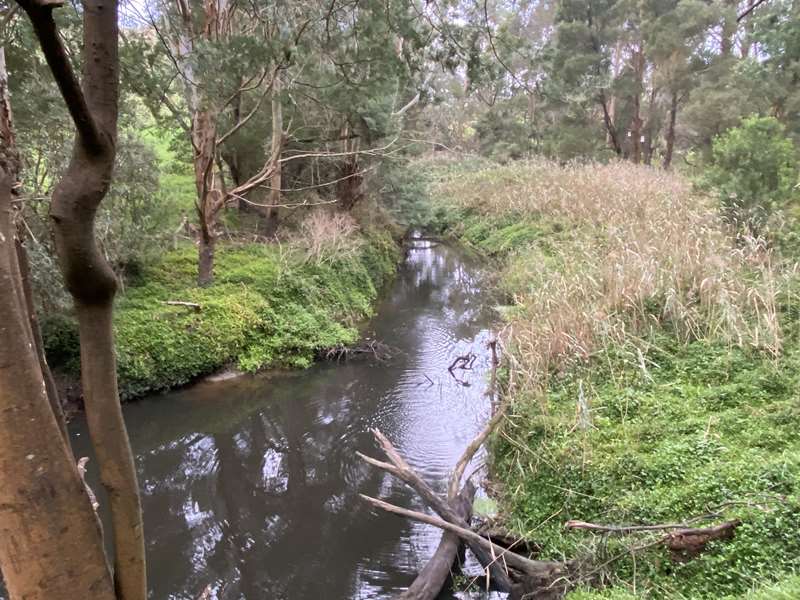Kongwak Pioneer Reserve


Kongwak Pioneer Reserve is a memorial to the original settlers of the area.
The reserve has a variety of walking tracks for all levels, picnic tables, information signage and a virtual tour that can be accessed via an app for a smart phone that will give an audio of the reserve's history, flora and fauna.

Kongwak Pioneer Reserve Map

Kongwak Pioneer Reserve Legend

Tracks in the reserve:
Stan Miles Track (easy, 25 minutes)
Creek Track (easy, 30 minutes)
Creek /Zig-Zag /Ridge Track (moderate, 45 minutes)
History of the Reserve
The Kongwak Pioneer Reserve owes its existence to the foresight of one man - Mr. Stan Miles, a former councillor and shire president of Korumburra Shire Council. It was Stan Miles' impassioned speech to Council in the early nineteen seventies that resulted in the Pioneer Reserve being retained as a council reserve, a memorial to the original settlers who contended with this landscape.
The original settlers cleared the Land, the eucalypt forests and the scrub and only remnants of the great southern forest remains. Kongwak is the proud beneficiary of one such remnant. Today the Kongwak Pioneer Reserve stands in stark contrast to the rolling hilts and pastures that surround it. It represents the largely untouched flora that once covered this area.
Thanks to a visionary councillor, who had the foresight to persuade council to retain the land, we can explore and enjoy this remnant bush land and reflect on what this landscape may have looked like in years gone by.
Access for Dogs:
Dogs and cars are not permitted in the reserve.
Restrictions
Fires and motor cycles are not permitted in the reserve.
Information Signs in the Reserve

2. Damp Forest
A tall eucalypt overstory with a medium to tall dense shrub layer containing broad-leafed species typical of wet forest, mixed with elements from dry forest types eg. Prickly or small-leaved shrubs
Overstory is dominated by Messmates, Narrow Leaf Peppermints and Mountain Ash. A secondary layer consists of Blackwood, Silver Wattle and Hazel Pomaderris over shrubs such as Victorian Christmas bush and Prickly Moses.
3. Hill Top
You are at the highest point of the reserve - 150m above sea level. This Lowland Forest area reflects the drier conditions compared with the Damp Forest areas of the lower reaches of the park.
The Forest Wire-grass (Tetrarrhena juncea) which once grew up to 3m high, provided a barrier for early settlers. Where it grew on flat, open, country, 300 to 600 mm high, it provided good winter fodder for cattle.
Other ground covers include Spiny-Headed Mat-Rush (Lomandra Longifolia) and Bracken Fern (Pteridium esculentum). Usually this is the first plant to re-establish after fire. The sap from the plant, especially a young one, when rubbed on the bite of the Australian Bull ant by Aborigines, acted as an antidote.
5. Tall Marsh
This small patch occurs along the terrace of the Foster Creek at the southern end of the reserve. It requires shallow water to 1m deep and low current.
Tall marsh occurs on the shallow side of the meandering bends of the creek. It is dominated by the Common Reed (Phragmotes australis) and grows 2 to 3m in height.
6. Riparian Forest
The Riparian Forest here occurs along Foster Creek and the adjacent alluvial terraces. Here the understory of Riparian forest has been cleared and slashed regularly.
The overstory is dominated by some mature Mountain Ash gums with a tall understorey of Blackwoods and Silver wattle. Understory shrubs are Hazel Pomaderris and Bergen. There are scattered dense patches of shrubs, ferns, grasses and herbs.
7. Mountain Ash
These trees here are unique in that they are growing at the lowest altitude naturally found anywhere on the Australian Mainland. They can grow in excess of 1m per year and up to 65m in 50 years.
8. Cherry Ballart
Grows from 3 to 8m high and have symbiotic relationships with adjacent plants. It depends on the roots of other trees initially, particularly eucalyptus.
The digestive juices of birds weaken the hard nut and allow germination to occur more easily. The "cherry" fruit is edible and used by the early settlers and aboriginals. The "cherry", whether yellow, pink or red is edible. On the other side of the track is the Tall Sword-sedge (Lepidospermaa elatius) and features throughout the reserve.
9. Forest Understory
The understory provides important cover for birdlife which help "cleanse" the forest by removing grubs.
Here there are examples of Sweet Bursaria (Bursaria ssp spinossa), Swamp Paperbark (Melaleuca ericifolia), Shiny Cassinia (Cassinia Longifolia) and Forest Wiregrass (Tetrarrhena juncea).
10. Lowland Forest
An open eucalypt forest typically without a tall layer. The overstory is dominated by Messmate (rough bark) and Narrow Leaf Peppermint.
Understory shrubs include Narrow-leaf Wattle, Shiny Cassinia, Common Heath and Broom Spurge At ground level Bracken is common together with Forest Wire-grass, Lomandra and Poa.
Review:
Park at the R N Scott Memorial Park which has a playground and tennis courts. Walk left of the pavilion and follow the path to the entrance of the reserve, which is about 170 m away.
At the entrance there is a picnic table and you can choose from three possible routes. There is a short, steep wide track along the Stan Miles Track leading to the highest point in the reserve. Whatever route you take through the reserve make sure you do the zig-zag track which is the most interesting area and passes through thick vegetation and exits near Foster Creek. Along Ridge Track there are two picnic tables. The reserve is very well signposted.
There are plenty of information signs. The Landcare group has done a great job developing and looking after this reserve.
Photos:
Location
1455 Korumburra-Wonthaggi Road, Kongwak 3951 View Map








